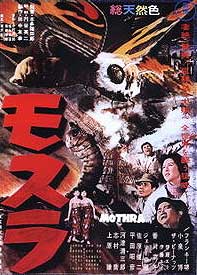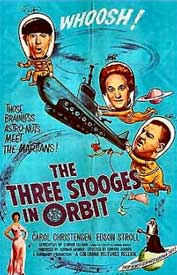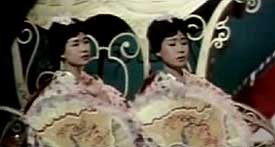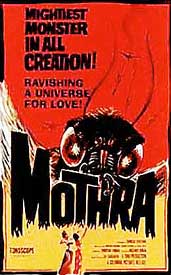 Mothra (Moshura, Toho, 1961) stands the test of time as one of the best Japanese monster movies, having an entirely sympathetic monster. Mothra (Moshura, Toho, 1961) stands the test of time as one of the best Japanese monster movies, having an entirely sympathetic monster.
When I was a kid, I saw this at the Midway Drive-in Theater near Seattle on a doublebill with the egregiously bad Three Stooges in Orbit (1962).
The Stooges were near the end of their career & would flail about for another three or four years before they pretty much hung it up.
No one wanted to incur much expense on another unfunny Stooges film, so they recycled footage from a pilot for an unsold tv series & added barely enough new footage to get the Stooges involved with the then-important topic of space flight, providing them with an opportunity to save the world from Martians.
 Even as a twelve year old I could barely go along with their recycled schtick, though it was curiously appealing to see the Stooges in space suits. The science fiction element was kept minimal. Even as a twelve year old I could barely go along with their recycled schtick, though it was curiously appealing to see the Stooges in space suits. The science fiction element was kept minimal.
The comedy Martians Ogg & Zogg want to destroy the world with a newly devised vehicle (paint it yellow & it'd be The Yellow Submarine), but since they're from Mars seems they'd have a better vehicle already. As a story it never makes a lick of sense; & as comedy, there's hardly any of that.
But the enormous shortcomings of Orbit were more than made up for by Mothra. It became one of my favorite childhood movies & when it turned up on television a very few years later, I loved it all over again, especially those tiny wee girls.
The titular gigantic moth is worshipped by a hidden Pacific island people as a protective Goddess. She was the guardian of this miniature race, scant inches tall, who are called the Cosmos, who once had an advanced civilization. Their remnant society & island is threatened by atomic bomb testing.
Two small female cantors or priestesses (twins) are kidnapped away from their island & taken to Japan to be unhappily exploited for their cutely freakish entertainment value singing eerily beautiful Mothra hymns.
Their goddess, a giant caterpillar from a giant egg, hears their song even from across the Pacific & sets out to save them.
To do so requires some fairly standard stomp-Tokyo scenes with caterpillar instead of Godzilla, proving herself impervious to military attack before weaving herself into a coccoon from which Mothra arises.
For little kids the special FX are spectacular. For adults the FX are more transparent, but still work in an expressionist sort of way, because for all ages the sympathetic nature of Mothra in protecting her helpless little Cosmo cantoresses is just so righteous a cause.
 The cantoresses themselves are ultra-appealing. In the undubbed original they sing two haunting songs; in the American edit they sing one haunting song. They travel in a tiny flying Edwardian carriage. Never have pop songs been so perfectly & beautifully woven into the fabric of a monster movie's story. The cantoresses themselves are ultra-appealing. In the undubbed original they sing two haunting songs; in the American edit they sing one haunting song. They travel in a tiny flying Edwardian carriage. Never have pop songs been so perfectly & beautifully woven into the fabric of a monster movie's story.
They were played by twin sister pop singers Emi & Yumi Ito, the Olsen Twins of their day, recording hit songs under the cutesie name The Peanuts. casting them as shobijin ("beautiful fairy twins") in Mothra was a brilliant touch, & making them tragic & melancholy was splendidly improved their generally cutsie-poo image as entertainers.
They would reprise their role as the shobijin in Godzilla vs. Mothra (Mosura tai Gojira, 1964) & Ghidora the Three-headed Monster (San daikaiju: Chikyu saidai no kessen, 1964). At the height of the international fame that followed they toured the world & appeared in America on the Ed Sullivan Show (September 18, 1966) on the same bill with Herman & the Hermits.
copyright © by Paghat the Ratgirl
|

